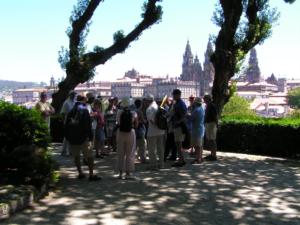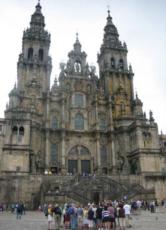
During the stopover in Bayona, Rally Portugal participants will visit the historic city of Santiago de Compostela. Our guide speaks excellent English and will bring the old streets alive for everyone.
Santiago de Compostela is the capital of the green and wooded region of Galicia in Northern Spain. It was originally a stopping point on a Roman road, but the discovery of the Apostle James’ tomb at the beginning of the 9th century gave rise to a place of worship in this corner of the Iberian Peninsula, which was then dominated by the Moors.
From then on all of Europe started walking towards Santiago, a holy city of Christendom, where absolution awaited them. Known as the Camino de Santiago (Way of Saint James), thousands of Pilgrims walk to Santiago (some ride on their bicycles or horses) every year. The main square in front of the Cathedral is awash with all nationalities having just arrived in this holy place after weeks of walking, many being greeted by their families who have come to meet them. Unesco now considers Santiago de Compostela a World Heritage Site.
 As well as the pilgrims, Santiago attracts visitors from all over the world thanks to it’s monumental cathedral, originally Romanesque but added to over the centuries with Renaissance and Baroque style, and numerous churches, stately homes and atmospheric squares where time stands still.
As well as the pilgrims, Santiago attracts visitors from all over the world thanks to it’s monumental cathedral, originally Romanesque but added to over the centuries with Renaissance and Baroque style, and numerous churches, stately homes and atmospheric squares where time stands still.
Santiago is certainly one of Spain's most monumental towns; with a particular architectonical style all of its own. But it’s also a town full of life, with one of the most famous Universities and a large number of students who guarantee youthful ambience in-between the historical walls. The region's cuisine also has quite a reputation, and it is said that nowhere can you eat better seafood than in Galicia.